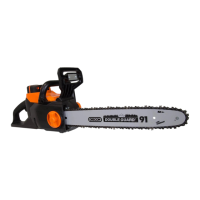99
BATTERY & CHARGER INSTRUCTIONS
ABOUT THE BATTERY:
1. The battery pack supplied with your cordless tool is only partially charged. The battery pack has to be charged
completely before you use the tool for the first time.
2. For optimum battery performance, avoid low discharge cycles by charging the battery pack frequently.
3. Lithium-ion batteries are subject to a natural aging process. The battery pack must be replaced at the latest
when its capacity falls to just 80% of its capacity when new. Weakened cells in an aged battery pack are no longer
capable of meeting the high power requirements needed for the proper operation of your tool, and therefore pose
a safety risk.
4. Do not throw battery packs into an open fire as this poses a risk of explosion. Do not ignite the battery pack or
expose it to fire.
5. Do not exhaustively discharge batteries. Exhaustive discharge will damage the battery cells. The most common
cause of exhaustive discharge is lengthy storage or non-use of partially discharged batteries. Stop working as soon
as the performance of the battery falls noticeably or the electronic protection system triggers. Place the battery
pack in storage only after it has been fully charged.
6. Protect batteries and the tool from overloads. Overloads will quickly result in overheating and cell damage
inside the battery housing even if this overheating is not apparent externally.
7. Avoid damage and shocks. Immediately replace batteries that have been dropped from a height of more than
one meter or those that have been exposed to violent shocks, even if the housing of the battery pack appears to be
undamaged. The battery cells inside the battery may have suffered serious damage. In such instances, please read
the waste disposal information for proper battery disposal.
8. If the battery pack suffers overloading and overheating, the integrated protective cutoff will switch off the equip-
ment for safety reasons.
9. Use only original battery packs. The use of other batteries poses a fire risk and may result in injuries or an
explosion.
• Battery chemicals cause serious burns – Never let a damaged battery pack contact the skin, eyes or
mouth. If a damaged battery pack leaks battery chemicals, use rubber or neoprene gloves to safely dispose of it.
If skin is exposed to battery fluids, wash the affected area with soap and water and rinse with vinegar. If eyes are
exposed to battery chemicals, immediately flush with water for 20 minutes and seek medical attention. Remove
and dispose of contaminated clothing.
• Do not short circuit – A battery pack will short circuit if a metal object makes a connection between the posi-
tive and negative contacts on the battery pack. Do not place a battery pack near anything that may cause a short
circuit, such as paper clips, coins, keys, screws, nails and other metallic objects. A short-circuited battery pack
poses a risk of fire and severe personal injury.
• Store your battery pack and charger in a cool, dry place – Do not store the battery pack or charger
where temperatures may exceed 104 °F, such as in direct sunlight or inside a vehicle or metal building during the
summer.

